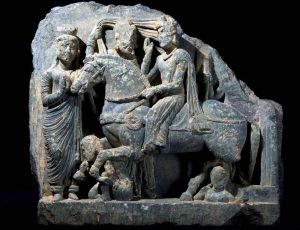Sculptures and carvings dating back more than 1,700 years have been discovered in the remains of a shrine and its courtyard in the ancient city of Bazira (Pakistan). One of the sculptures, carved in green schist, depicts a prince named Siddhartha leaving a palace on a horse named Kanthaka. According to ancient Buddhist stories, Siddhartha was a wealthy prince who lived a cloistered life, but one day he ventured outside his palace and encountered the suffering faced by common people. After this experience, he decided to leave his palace to live as a poor man in order to seek enlightenment.

In the courtyard, archaeologists found another carving, this one dating to a time after an earthquake had damaged the shrine. The carving pictures an unknown deity, an aged male figure sitting on a throne, with long, curled hair, holding a wine goblet and a severed goat head in his hands. The goat’s head in the carving is associated to the mountains in the cultures of Hindu Kush.

Bazira, also called Vajirasthana, was first constructed as a small town, during the second century B.C., and eventually developed into a city located within the Kushan Empire. At its peak, this empire ruled territory extending from modern-day India to central Asia. The Kushan Empire declined during the third century A.D., at the same time that a series of earthquakes ravaged the city.
(after Live Science)